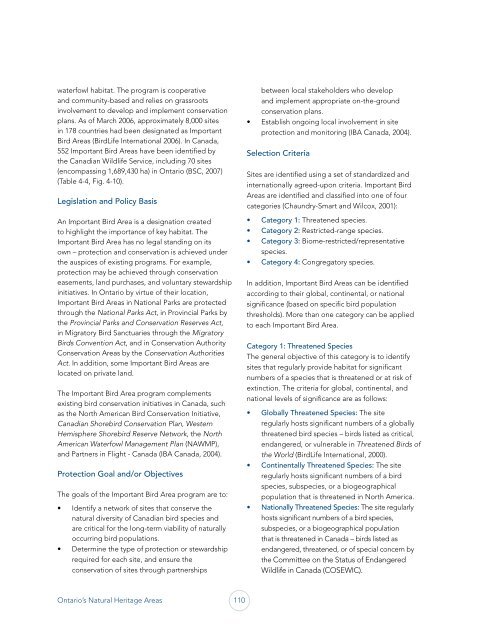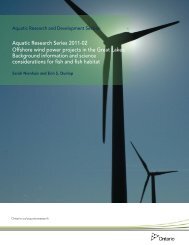Ontario's Natural Heritage Areas - Ministry of Natural Resources
Ontario's Natural Heritage Areas - Ministry of Natural Resources
Ontario's Natural Heritage Areas - Ministry of Natural Resources
You also want an ePaper? Increase the reach of your titles
YUMPU automatically turns print PDFs into web optimized ePapers that Google loves.
waterfowl habitat. The program is cooperative<br />
and community-based and relies on grassroots<br />
involvement to develop and implement conservation<br />
plans. As <strong>of</strong> March 2006, approximately 8,000 sites<br />
in 178 countries had been designated as Important<br />
Bird <strong>Areas</strong> (BirdLife International 2006). In Canada,<br />
552 Important Bird <strong>Areas</strong> have been identified by<br />
the Canadian Wildlife Service, including 70 sites<br />
(encompassing 1,689,430 ha) in Ontario (BSC, 2007)<br />
(Table 4-4, Fig. 4-10).<br />
Legislation and Policy Basis<br />
An Important Bird Area is a designation created<br />
to highlight the importance <strong>of</strong> key habitat. The<br />
Important Bird Area has no legal standing on its<br />
own – protection and conservation is achieved under<br />
the auspices <strong>of</strong> existing programs. For example,<br />
protection may be achieved through conservation<br />
easements, land purchases, and voluntary stewardship<br />
initiatives. In Ontario by virtue <strong>of</strong> their location,<br />
Important Bird <strong>Areas</strong> in National Parks are protected<br />
through the National Parks Act, in Provincial Parks by<br />
the Provincial Parks and Conservation Reserves Act,<br />
in Migratory Bird Sanctuaries through the Migratory<br />
Birds Convention Act, and in Conservation Authority<br />
Conservation <strong>Areas</strong> by the Conservation Authorities<br />
Act. In addition, some Important Bird <strong>Areas</strong> are<br />
located on private land.<br />
The Important Bird Area program complements<br />
existing bird conservation initiatives in Canada, such<br />
as the North American Bird Conservation Initiative,<br />
Canadian Shorebird Conservation Plan, Western<br />
Hemisphere Shorebird Reserve Network, the North<br />
American Waterfowl Management Plan (NAWMP),<br />
and Partners in Flight - Canada (IBA Canada, 2004).<br />
Protection Goal and/or Objectives<br />
The goals <strong>of</strong> the Important Bird Area program are to:<br />
• Identify a network <strong>of</strong> sites that conserve the<br />
natural diversity <strong>of</strong> Canadian bird species and<br />
are critical for the long-term viability <strong>of</strong> naturally<br />
occurring bird populations.<br />
• Determine the type <strong>of</strong> protection or stewardship<br />
required for each site, and ensure the<br />
conservation <strong>of</strong> sites through partnerships<br />
Ontario’s <strong>Natural</strong> <strong>Heritage</strong> <strong>Areas</strong> 110<br />
between local stakeholders who develop<br />
and implement appropriate on-the-ground<br />
conservation plans.<br />
• Establish ongoing local involvement in site<br />
protection and monitoring (IBA Canada, 2004).<br />
Selection Criteria<br />
Sites are identified using a set <strong>of</strong> standardized and<br />
internationally agreed-upon criteria. Important Bird<br />
<strong>Areas</strong> are identified and classified into one <strong>of</strong> four<br />
categories (Chaundry-Smart and Wilcox, 2001):<br />
• Category 1: Threatened species.<br />
• Category 2: Restricted-range species.<br />
• Category 3: Biome-restricted/representative<br />
species.<br />
• Category 4: Congregatory species.<br />
In addition, Important Bird <strong>Areas</strong> can be identified<br />
according to their global, continental, or national<br />
significance (based on specific bird population<br />
thresholds). More than one category can be applied<br />
to each Important Bird Area.<br />
Category 1: Threatened Species<br />
The general objective <strong>of</strong> this category is to identify<br />
sites that regularly provide habitat for significant<br />
numbers <strong>of</strong> a species that is threatened or at risk <strong>of</strong><br />
extinction. The criteria for global, continental, and<br />
national levels <strong>of</strong> significance are as follows:<br />
• Globally Threatened Species: The site<br />
regularly hosts significant numbers <strong>of</strong> a globally<br />
threatened bird species – birds listed as critical,<br />
endangered, or vulnerable in Threatened Birds <strong>of</strong><br />
the World (BirdLife International, 2000).<br />
• Continentally Threatened Species: The site<br />
regularly hosts significant numbers <strong>of</strong> a bird<br />
species, subspecies, or a biogeographical<br />
population that is threatened in North America.<br />
• Nationally Threatened Species: The site regularly<br />
hosts significant numbers <strong>of</strong> a bird species,<br />
subspecies, or a biogeographical population<br />
that is threatened in Canada – birds listed as<br />
endangered, threatened, or <strong>of</strong> special concern by<br />
the Committee on the Status <strong>of</strong> Endangered<br />
Wildlife in Canada (COSEWIC).

















